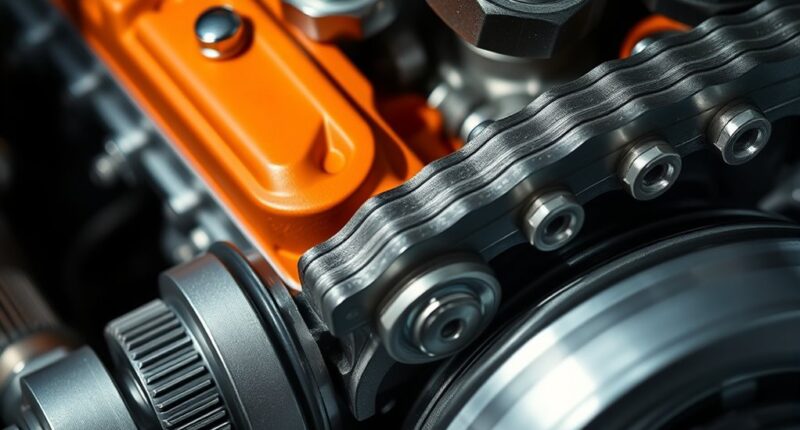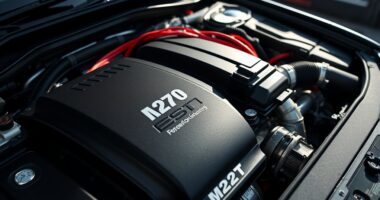If you’re experiencing start-up rattle in your M276 engine, upgrading the timing chain tensioner can make a big difference. Worn or weak tensioners often cause slack and noise, but replacing it with a high-quality aftermarket part restores proper tension and quiets the engine. This upgrade reduces chain noise, prevents future damage, and improves reliability. For detailed steps and tips on upgrading your tensioner effectively, keep exploring further.
Key Takeaways
- Upgrading the M276 timing chain tensioner reduces startup rattling by maintaining proper chain tension.
- A high-quality aftermarket tensioner restores smooth engine operation and minimizes chain noise during start-up.
- Proper tensioner replacement prevents slack that causes rattling and chain slap at engine start.
- Upgrades improve engine reliability, preventing potential damage from worn or failing tensioners.
- Regular inspections after upgrade help ensure the tensioner functions correctly and prolongs chain lifespan.

Are you experiencing timing chain issues with your M276 engine? If you’ve noticed a rattling sound during startup or while idling, it’s likely due to chain noise caused by a worn or failing tensioner. This noise can be unsettling and may signal that your engine’s timing components aren’t functioning *at their best*. Addressing this early is *essential* to prevent more severe damage down the line. Upgrading your timing chain tensioner can *considerably* reduce or eliminate this problem, restoring smooth operation and peace of mind.
The first step is understanding the role of the tensioner. It keeps the timing chain tight, ensuring proper synchronization between the crankshaft and camshafts. When the tensioner wears out or becomes weak, slack develops in the chain, leading to chain noise—often heard as a rattle during engine start-up. This noise isn’t just annoying; it’s an indicator that your tensioner might need attention or replacement. Performing tensioner repair or upgrading to a more robust, aftermarket tensioner can help maintain proper tension, reduce chain noise, and improve engine reliability.
Upgrading your tensioner isn’t complicated, but it does require some mechanical know-how. First, you’ll need to remove the engine cover and access the timing chain area. Carefully release the old tensioner, noting its position for proper installation of the new component. Installing an upgraded tensioner typically involves replacing the original with a high-quality aftermarket part designed to withstand wear and maintain consistent tension over time. These upgraded tensioners often feature improved damping properties, which can help dampen chain noise and reduce the likelihood of future tensioner failure.
Upgrading your tensioner involves removing the engine cover and installing a high-quality aftermarket part.
Once installed, it’s essential to verify that the tensioner is functioning correctly. Start the engine and listen for any remaining chain noise. A properly functioning tensioner will keep the chain taut and prevent rattling sounds during startup. Regular inspections can help catch early signs of tensioner wear, especially if you notice increased chain noise or unusual engine sounds. Investing in a tensioner upgrade can extend the lifespan of your timing chain and prevent costly repairs caused by chain slap or misalignment.
Frequently Asked Questions
How Long Do Timing Chain Tensioner Upgrades Typically Last?
You’re wondering how long timing chain tensioner upgrades last. Typically, these upgrades can last between 80,000 to 120,000 miles, depending on driving habits and maintenance. They effectively reduce chain noise and prevent future issues. Proper care and regular inspections can extend the upgrade lifespan, ensuring your engine runs smoothly. Keep an eye out for signs of wear to catch problems early and maintain peak performance.
Are Aftermarket Tensioners as Reliable as OEM Parts?
You might wonder if aftermarket tensioners are as reliable as OEM parts. While aftermarket options often cost less, they don’t always match OEM quality, which is engineered for your specific engine. If you prioritize longevity and peak performance, sticking with OEM parts is wise. However, some high-quality aftermarket tensioners can offer comparable reliability at a lower cost, but always research thoroughly to guarantee they meet your vehicle’s standards.
What Are the Signs of a Failing Timing Chain Tensioner?
You’ll notice signs of a failing timing chain tensioner through increased timing chain noise and engine rattling. If your engine sounds louder or has a persistent rattling, especially during startup or acceleration, it’s a warning sign. These noises indicate the tensioner isn’t maintaining proper tension, which can lead to further engine issues. Addressing these symptoms early helps prevent more costly repairs and keeps your engine running smoothly.
Can Tensioner Upgrades Improve Overall Engine Performance?
You might think upgrading your tensioner is just about avoiding rattle, but it can do more. Improved tensioners help maintain proper timing, which enhances fuel efficiency and reduces oil consumption. When your engine runs smoothly, performance gets a boost, and you save money in the long run. Upgrades can keep your engine humming, making sure you’re not chasing your tail and getting the most out of your vehicle.
Is Professional Installation Necessary for Tensioner Upgrades?
You should definitely opt for professional installation when upgrading your tensioner. DIY installation can be tricky and requires precise knowledge, especially with aftermarket quality parts. A skilled mechanic ensures proper fitment and reduces the risk of future issues. While some experienced enthusiasts might handle it themselves, professional installation guarantees the upgrade’s effectiveness and longevity, giving you peace of mind and keeping your engine running smoothly.
Conclusion
Now that you’ve upgraded your M276’s timing chain tensioner, say goodbye to that nerve-wracking start-up rattle forever. You’ll feel like you just gave your engine a superpower boost, transforming it into a silent, smooth-running beast. No more annoying clatter or worry about catastrophic failure—just pure driving bliss. With this upgrade, you’ll be the hero, keeping your engine humming happily and confidently, ready to conquer every road like a true automotive legend!










